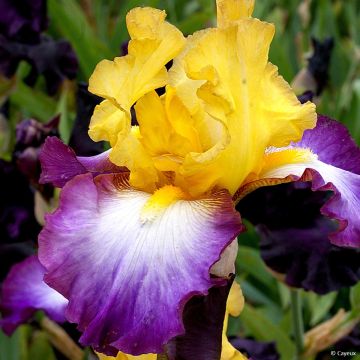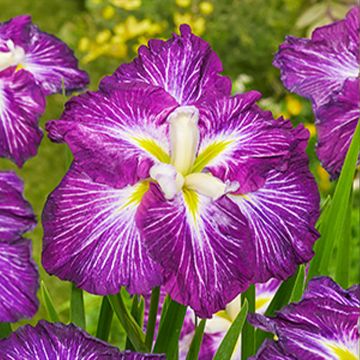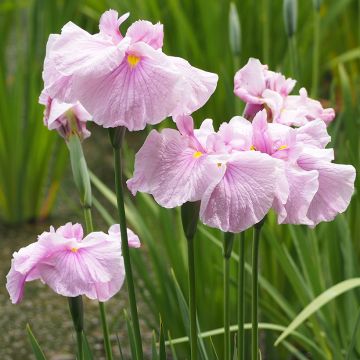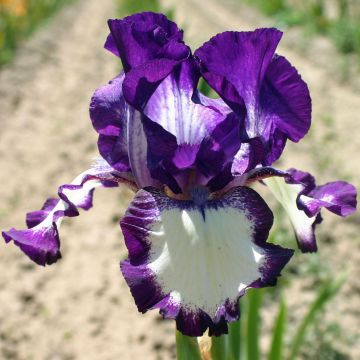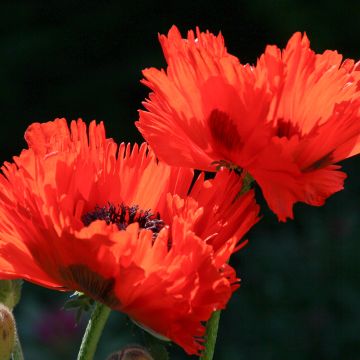

Iris hoogiana


Iris hoogiana
Iris hoogiana
Iris hoogiana
aril iris
Special offer!
Receive a €20 voucher for any order over €90 (excluding delivery costs, credit notes, and plastic-free options)!
1- Add your favorite plants to your cart.
2- Once you have reached €90, confirm your order (you can even choose the delivery date!).
3- As soon as your order is shipped, you will receive an email containing your voucher code, valid for 3 months (90 days).
Your voucher is unique and can only be used once, for any order with a minimum value of €20, excluding delivery costs.
Can be combined with other current offers, non-divisible and non-refundable.
Why not try an alternative variety in stock?
View all →This plant carries a 6 months recovery warranty
More information
We guarantee the quality of our plants for a full growing cycle, and will replace at our expense any plant that fails to recover under normal climatic and planting conditions.

Would this plant suit my garden?
Set up your Plantfit profile →
Description
Iris hoogiana is a perennial plant that comes from Turkestan. This species, intermediate between rhizomatous irises and bulbous irises, is renowned for its fragrant flowering in a lovely lavender blue and its ease of cultivation in well-drained soil. It is a wild iris adapted to cold winters (-15°C) and dry summers.
The Hoog Iris is a rhizomatous perennial plant of the iridaceae family that develops thanks to a rhizome often contracted into a bulbous shape. This rhizome produces numerous stolons that can reach considerable lengths. Native to the regions of Kazakhstan, Kyrgyzstan, Uzbekistan, Tajikistan, and Turkmenistan, this plant was introduced to Europe by Mr. CG van Tubergen in 1913. This iris, dedicated to the Hoog brothers, is characterised by a uniform colouration of all parts of the flower, except for its well-developed golden yellow beards. From a botanical point of view, it is classified in the Iris Regelia section. This plant received an AGM from the Royal Horticultural Society in 1919.
The Hoog Iris has a graceful habit, forming a clump of long, slightly curved green leaves, from which emerge tall flowering stems reaching about 50 centimetres in height. The leaves measure between 35 and 45 cm in length and up to 2 cm in width. The short flowering occurs from April to May, in the form of blue flowers ranging from sky blue to lavender blue and purple-blue. Each flower has three large trailing sepals adorned with a yellow crest and three smaller upright petals. The beard, at the base of each sepal, is a contrasting orange or bright yellow. Each floral stem can bear 2 to 3 flowers at its top. The flower buds are wrapped in an herbaceous sheath tinged with purple at its tip. Its foliage is deciduous, growing in spring and disappearing in autumn.
The Hoog Iris is a versatile plant that easily fits into sunny spots in the garden, both in rockeries and border beds. It pairs well with its cousins, the bearded Iris, lavenders, Sedum spectabile 'Carl', Achillea millefolium 'Cassis', or pink-flowered bushy salvias.
Report an error about the product description
Plant habit
Flowering
Foliage
Botanical data
Iris
hoogiana
Iridaceae
aril iris
Iris splendens
Central Asia
Other Iris A to Z
View all →Planting and care
Do you have a very sunny location, rather dry in summer?
This is the ideal location for planting irises! In the shade, they grow but do not flower. They are hardy and do not need winter protection. Well-drained soil is perfect, even if it is rather dry and chalky, or even rocky. Soil that is too wet promotes rhizome rot. Plant from July to September. This allows the rhizomes to grow and develop new roots before winter. They should be planted as soon as they are purchased for best results. Plan to divide irises every 4 years or so to give them fresh soil. They have vigorous growth and require space to develop and flower well. Plant with spacing appropriate to the size and vigour of the variety: about 34-50 cm for tall ones (5 to 10 feet per square metre). Always consider the direction of growth of the rhizomes by arranging them in a star shape, with buds and leaves facing outward, and well away from other varieties so they have room to grow.
Planting
Dig a hole that is wide and deep enough. Make a conical mound of soil in the hole, on which the rhizome and spread-out roots are placed. Cover the roots. It is important that the rhizome is level with the surface of the soil. It should not be planted in a dip (risk of rot). Take into account that the soil will settle and the iris will sink. In clayey or moist soil, the rhizome can even be raised on a slight mound of a few centimetres. To make the soil cling to the roots, gently firm the soil and water it abundantly immediately after planting. Water 2-3 times if necessary until it takes root.
Maintenance:
Keep the soil free of weeds by shallow hoeing, taking care not to damage the rhizomes or roots. Weeds shade the irises, retain moisture (rot), and attract slugs. Similarly, remove dry leaves. If they are diseased (reddish-brown spots of heterosporiosis), we recommend burning them. Remove faded flowers.
Planting period
Intended location
Care
Planting & care advice
This item has not been reviewed yet - be the first to leave a review about it.
Similar products
Haven't found what you were looking for?
Hardiness is the lowest winter temperature a plant can endure without suffering serious damage or even dying. However, hardiness is affected by location (a sheltered area, such as a patio), protection (winter cover) and soil type (hardiness is improved by well-drained soil).

Photo Sharing Terms & Conditions
In order to encourage gardeners to interact and share their experiences, Promesse de fleurs offers various media enabling content to be uploaded onto its Site - in particular via the ‘Photo sharing’ module.
The User agrees to refrain from:
- Posting any content that is illegal, prejudicial, insulting, racist, inciteful to hatred, revisionist, contrary to public decency, that infringes on privacy or on the privacy rights of third parties, in particular the publicity rights of persons and goods, intellectual property rights, or the right to privacy.
- Submitting content on behalf of a third party;
- Impersonate the identity of a third party and/or publish any personal information about a third party;
In general, the User undertakes to refrain from any unethical behaviour.
All Content (in particular text, comments, files, images, photos, videos, creative works, etc.), which may be subject to property or intellectual property rights, image or other private rights, shall remain the property of the User, subject to the limited rights granted by the terms of the licence granted by Promesse de fleurs as stated below. Users are at liberty to publish or not to publish such Content on the Site, notably via the ‘Photo Sharing’ facility, and accept that this Content shall be made public and freely accessible, notably on the Internet.
Users further acknowledge, undertake to have ,and guarantee that they hold all necessary rights and permissions to publish such material on the Site, in particular with regard to the legislation in force pertaining to any privacy, property, intellectual property, image, or contractual rights, or rights of any other nature. By publishing such Content on the Site, Users acknowledge accepting full liability as publishers of the Content within the meaning of the law, and grant Promesse de fleurs, free of charge, an inclusive, worldwide licence for the said Content for the entire duration of its publication, including all reproduction, representation, up/downloading, displaying, performing, transmission, and storage rights.
Users also grant permission for their name to be linked to the Content and accept that this link may not always be made available.
By engaging in posting material, Users consent to their Content becoming automatically accessible on the Internet, in particular on other sites and/or blogs and/or web pages of the Promesse de fleurs site, including in particular social pages and the Promesse de fleurs catalogue.
Users may secure the removal of entrusted content free of charge by issuing a simple request via our contact form.
The flowering period indicated on our website applies to countries and regions located in USDA zone 8 (France, the United Kingdom, Ireland, the Netherlands, etc.)
It will vary according to where you live:
- In zones 9 to 10 (Italy, Spain, Greece, etc.), flowering will occur about 2 to 4 weeks earlier.
- In zones 6 to 7 (Germany, Poland, Slovenia, and lower mountainous regions), flowering will be delayed by 2 to 3 weeks.
- In zone 5 (Central Europe, Scandinavia), blooming will be delayed by 3 to 5 weeks.
In temperate climates, pruning of spring-flowering shrubs (forsythia, spireas, etc.) should be done just after flowering.
Pruning of summer-flowering shrubs (Indian Lilac, Perovskia, etc.) can be done in winter or spring.
In cold regions as well as with frost-sensitive plants, avoid pruning too early when severe frosts may still occur.
The planting period indicated on our website applies to countries and regions located in USDA zone 8 (France, United Kingdom, Ireland, Netherlands).
It will vary according to where you live:
- In Mediterranean zones (Marseille, Madrid, Milan, etc.), autumn and winter are the best planting periods.
- In continental zones (Strasbourg, Munich, Vienna, etc.), delay planting by 2 to 3 weeks in spring and bring it forward by 2 to 4 weeks in autumn.
- In mountainous regions (the Alps, Pyrenees, Carpathians, etc.), it is best to plant in late spring (May-June) or late summer (August-September).
The harvesting period indicated on our website applies to countries and regions in USDA zone 8 (France, England, Ireland, the Netherlands).
In colder areas (Scandinavia, Poland, Austria...) fruit and vegetable harvests are likely to be delayed by 3-4 weeks.
In warmer areas (Italy, Spain, Greece, etc.), harvesting will probably take place earlier, depending on weather conditions.
The sowing periods indicated on our website apply to countries and regions within USDA Zone 8 (France, UK, Ireland, Netherlands).
In colder areas (Scandinavia, Poland, Austria...), delay any outdoor sowing by 3-4 weeks, or sow under glass.
In warmer climes (Italy, Spain, Greece, etc.), bring outdoor sowing forward by a few weeks.






























